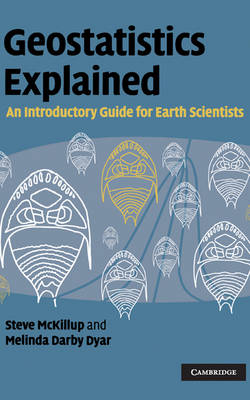
Geostatistics Explained
Cambridge University Press (Verlag)
978-0-521-76322-6 (ISBN)
A reader-friendly introduction to geostatistics for students and researchers struggling with statistics. Using simple, clear explanations for introductory and advanced material, it demystifies complex concepts and makes formulas and statistical tests easy to apply. Beginning with a critical evaluation of experimental and sampling design, the book moves on to explain essential concepts of probability, statistical significance and type 1 and type 2 error. An accessible graphical explanation of analysis of variance (ANOVA) leads onto advanced ANOVA designs, correlation and regression, and non-parametric tests including chi-square. Finally, it introduces the essentials of multivariate techniques, multi-dimensional scaling and cluster analysis, analysis of sequences and concepts of spatial analysis. Illustrated with wide-ranging examples from topics across the Earth and environmental sciences, Geostatistics Explained can be used for undergraduate courses or for self-study and reference. Worked examples at the end of each chapter reinforce a clear understanding of the statistical tests and their applications.
Steve McKillup is an Associate Professor in the Department of Biosystems and Resources at Central Queensland University. He has received several tertiary teaching awards, including the Vice-Chancellor's Award for Quality Teaching and a 2008 Australian Teaching and Learning Council citation 'For developing a highly successful method of teaching complex physiological and statistical concepts, and embodying that method in an innovative international textbook'. He is the author of Statistics Explained: An Introductory Guide for Life Scientists (Cambridge, 2006). His research interests include biological control of introduced species, the ecology of soft-sediment shores and mangrove swamps. Melinda Darby Dyar is an Associate Professor of Geology and Astronomy at Mount Holyoke College, Massachusetts. Her research interests range from innovative pedagogies and curricular materials to the characterization of planetary materials. She has studied samples from mid-ocean ridges and every continent on Earth, as well as from the lunar highlands and Mars. She is a Fellow of the Mineralogical Society of America, and the author or coauthor of more than 130 refereed journal articles. She is the author of two mineralogy DVDs used in college-level teaching, and a textbook, Mineralogy and Optical Mineralogy (2008).
Preface; 1. Introduction; 2. 'Doing science': hypotheses, experiments and disproof; 3. Collecting and displaying data; 4. Introductory concepts of experimental design; 5. Doing science responsibly and ethically; 6. Probability helps you make a decision about your results; 7. Working from samples: data, populations and statistics; 8. Normal distributions: tests for comparing the means of one and two samples; 9. Type 1 and type 2 error, power and sample size; 10. Single factor analysis of variance; 11. Multiple comparisons after ANOVA; 12. Two-factor analysis of variance; 13. Important assumptions of analysis of variance: transformations and a test for equality of variances; 14. Two-factor analysis of variance without replication, and nested analysis of variance; 15. Relationships between variables: linear correlation and linear regression; 16. Linear regression; 17. Non-parametric statistics; 18. Non-parametric tests for nominal scale data; 19. Non-parametric tests for ratio, interval or ordinal scale data; 20. Introductory concepts of multivariate analysis; 21. Introductory concepts of sequence analysis; 22. Introductory concepts of spatial analysis; 23. Choosing a test; Appendix A. Critical values of chi-square, Student's t and F; Appendix B. Answers to questions; References; Index.
| Zusatzinfo | Worked examples or Exercises; 93 Tables, unspecified; 110 Halftones, unspecified; 90 Line drawings, unspecified |
|---|---|
| Verlagsort | Cambridge |
| Sprache | englisch |
| Maße | 152 x 229 mm |
| Gewicht | 780 g |
| Themenwelt | Mathematik / Informatik ► Mathematik |
| Naturwissenschaften ► Geowissenschaften ► Geologie | |
| ISBN-10 | 0-521-76322-3 / 0521763223 |
| ISBN-13 | 978-0-521-76322-6 / 9780521763226 |
| Zustand | Neuware |
| Haben Sie eine Frage zum Produkt? |
aus dem Bereich


